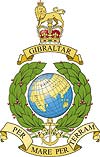 This information has been archived for reference or research purposes.
This information has been archived for reference or research purposes.
Archived Content
Information identified as archived on the Web is for reference, research or recordkeeping purposes. It has not been altered or updated after the date of archiving. Web pages that are archived on the Web are not subject to the Government of Canada Web Standards. As per the Communications Policy of the Government of Canada, you can request alternate formats on the "Contact Us" page.
History
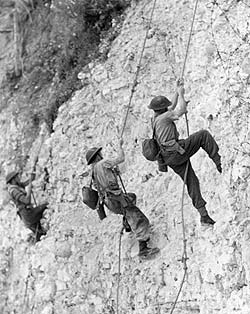
LAC photo PA 213630 by Lt. Royal Commando training – scaling cliffs. |
|
strength born from weakness: the establishment of the raiding concept and the british commandos
For more information on accessing this file, please visit our help page.
Introduction
The waves crashed noisily onto the beach as the German sentry pulled up his collar to ward off the chill that blew off the English Channel. He hunched his shoulders involuntarily inside his heavy wool greatcoat as he trudged along the beach on the way back to the patrol house. He suddenly stopped, his sixth sense warning him of danger, but as he turned into the icy, cold wind he saw nothing, and heard only the relentless swells hammering the French coastline. He picked up his pace and began to think of the warmth he would soon enjoy, when he realized, too late, that he was not alone. Before, he could turn or unsling his rifle, his head was violently jerked to one side as the cold steel of a fighting knife was thrust into his carotid artery. The body of the lifeless sentry was gently lowered to the ground by a phantom-like figure. Suddenly, as if on cue, more figures emerged from the shadows, clutching sub-machine guns and demolitions. The commandos had arrived once more to visit death and destruction on Hitler’s occupied territories.
This obscure drama passed into history without notice or fanfare. It was just another tragic act in a chaotic world. However, it was the living embodiment of Winston Churchill’s vision. “There comes from the sea,” he proclaimed in the dark early days of the war, “a hand of steel that plucks the German sentries from their posts.”1 As dramatic and inspiring as the Prime Minister’s words were, they were not delivered from a position of strength. Rather, they were born from weakness.
The speed and violence of the German invasion of Europe in the spring of 1940 caught the British and the French, still stuck in their Great War mentality, totally by surprise. The military subjugation of western Europe took just 46 days, but it was decided in only ten. The last available members of the British Expeditionary Forces in France were evacuated from the beaches of Dunkirk on the night of 2 June 1940. Significantly, the desperate withdrawal resulted in the loss of virtually all their heavy equipment, weapons and transport. Britain now braced for what appeared to be the inevitable conclusion to the German master plan – the invasion of England.
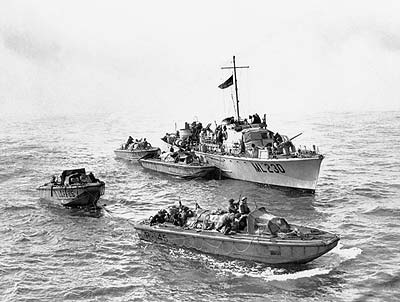
LAC photo PA 113247
Commando training exercise with small craft.
In the Beginning
Devoid of any major equipment or weapons, and encumbered by a doctrine and warmaking methodology that was clearly defunct, England was on the precipice of disaster. Simultaneously, it had to re-equip, rebuild and retrain its armed forces – and this, in addition to preparing the island for its defence. It appeared that Britain had no other choice but to surrender the initiative, dig in, and await the inescapable assault.
But this was not to be. Despite the still-smouldering British equipment strewn upon the beaches of Dunkirk, Churchill, Great Britain’s combative new prime minister, declared in the House of Commons, on 4 June 1940: “We shall not be content with a defensive war.’2 He was well aware that winning a war ultimately required offensive action. Moreover, only through offensive action could an army provide the needed confidence and battle experience to its soldiers and leaders. Furthermore, only offensive action could sustain public and military morale. And finally, offensive action represented a shift in initiative. By striking at the enemy, an opponent is inherently forced to take defensive measures, and that generates a diversion of scarce resources.
That afternoon, Churchill penned a note to his Chief of Staff of the War Cabinet Secretariat, General Hastings Ismay: “We are greatly concerned ...with the dangers of the German landing in England,” he wrote, “...why should it be thought impossible for us to do anything of the same kind to them?” He then added: “We should immediately set to work to organize self-contained, thoroughly equipped raiding units.”3 After all, pondered Churchill, “how wonderful it would be if the Germans could be made to wonder where they were going to be struck next, instead of forcing us to try to wall in the island and roof it over!”4
Two days later, Churchill sent yet another missive to Ismay: “Enterprises must be prepared,” he wrote, “with specially-trained troops of the hunter class who can develop a reign of terror down these coasts, first of all on the butcher and bolt policy.” He then curtly directed: “...the Joint Chiefs of the Staff to propose me measures for a vigorous, enterprising, and ceaseless offensive against the whole German-occupied coastline.”5
Churchill’s ruminations and subsequent missive were passed to the Chief of the Imperial General Staff (CIGS), General Sir John Dill. The CIGS wasted no time. He passed the problem to one of his general staff officers, Lieutenant-Colonel Dudley W. Clarke, with direction to find means by which the offensive spirit of the army could be fostered until it was in a position to resume the offensive. Clarke began work immediately. Like Churchill, he realized that “even the lightest threats... must compel the Germans to turn in the midst of their feverish invasion preparations to organise defence and divert troops to guard this enormous front line [Occupied Europe].”6
To Clarke, the solution was simple – guerrilla operations. This, he believed, was the best model the British could adopt under the existing conditions. Therefore, he proposed that ‘commandos,’ the term taken directly from the Boer War experience, be established to, firstly, create a threat to divert German resources, and, secondly, to restore the offensive spirit to the British Army.7 Dill passed the idea to Churchill, who leapt on it immediately. After all, it appealed to his character. Winston Churchill, himself an accomplished adventurer, journalist and soldier, held a heroic and romantic image of war. Moreover, he maintained “an almost abstract attachment to the offensive.”8 He believed that audacity and willpower constituted the only sound approach to the conduct of war.9 He later penned a note to President Franklin D. Roosevelt that revealed his mindset: “[The] essence of defence,” he asserted, “is to attack the enemy upon us – leap at his throat and keep the grip until the life is out of him.”10
Dissent and Accord
And so it came to pass. Despite resistance from many senior military commanders, who felt that valuable resources were being frittered away for no valuable return at a time when the nation faced invasion, Churchill pressed on with his initiatives. In a remarkable display of military efficiency, by 8 June 1940 General Dill had received approval for the creation of the commandos, and that same afternoon, Section MO9 of the War Office was established. Four days later, Churchill appointed Lieutenant-General Sir Alan Bourne, the Adjutant-General of the Royal Marines as “Commander of Raiding Operations on Coasts in Enemy Occupation and Advisor to the Chiefs of Staff on Combined Operations.”11
Dudley Clarke’s concept was coming to life. He could now establish his “picked bands of guerrilla fighters who would harry the long enemy coastline in order to make him [Germans] dissipate his superior resources.”12 In all, twelve Commando units, consisting of 500 men, broken up into a headquarters and ten troops each, were proposed. Incredibly, Lieutenant-Colonel Clarke was also directed to mount a cross-Channel raid, “at the earliest possible moment.”13
Fielding a Force
The next hurdle consisted of actually raising the force. It was considered axiomatic from the beginning that no existing units of the army could be made available for raiding operations, nor could any personnel be diverted from the unavoidable necessity of home defence. The corollary condition was one of stringent economy. So acute was the shortage of equipment and weaponry that commandos were “armed, equipped, organised and administered for one task and one task only – tip-and-run raids of not more than 48 hours from bases in England against the Continent of Europe.”14 The problem was so severe that a commando unit drew its full complement of weapons, such as submachine guns, from a central pool, and then only when it was about to set out on a raid.15
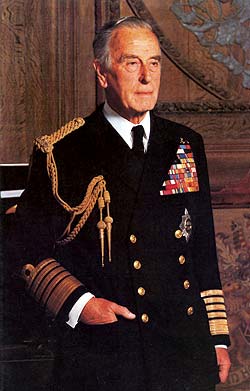
Photo by Bern Schwartz
Lord Mountbatten, Chief of Combined Operations from October 1941.
With respect to manpower, Clarke was somewhat more fortunate. The cadre of 1 and 2 Commandos were harvested from the ten Independent Companies that had been raised earlier in the year to harass the advancing Germans in Norway. The ten Independent Companies, each consisting of approximately 20 officers and 270 men, were raised largely from second-line Territorial Army divisions in April 1940. These units were designed exclusively for raiding, and, as such, they were self-contained in an assigned ship that was to be their floating base. They had no garrison, and were billeted in private homes in coastal towns. However, the chaos created with the German assault on Norway forestalled any real preparation. There was practically no training for the militia soldiers or leaders of the Independent Companies before they were deployed to that beleaguered country.
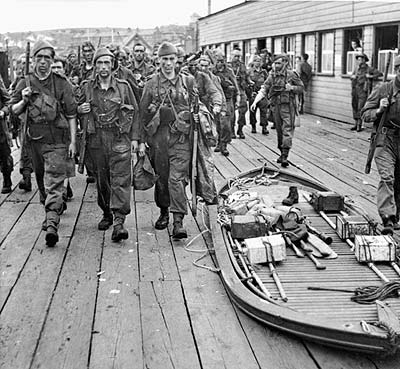
LAC photo PA 141307
A group of commandos march past a collapsed Goatley boat upon returning from a raid on the French coast.
Nonetheless, the German advance in Norway was extremely rapid, and the five Independent Companies that actually made it to Norway in time were withdrawn by early June. In the end, they conducted no raids and very little action that could be called guerrilla warfare. In fact, overall, there was very little contact with the enemy.16
Their disbandment provided an immediate pool of manpower. However, the inexperience of the territorial troops was seen as incompatible with the intended concept, and, as a result, under pressure from Churchill, recruiting for the remaining commandos was done by asking for volunteers for “special service of a hazardous nature” from the regular army.17 Prospective candidates were required to be fully trained men. Commanding officers were picked from the volunteers, and were then given a free hand to choose their own officers, who, in turn, were dispatched to various units to select their own men.
The theoretical construct for selection was sound. The nature of commando operations dictated that volunteers were to be the best possible material. As such, initially, officers and men were handpicked from volunteers. “Great care,” revealed one report, “was taken in the selection of officers and men and from the outset they were specially picked units.”18 Recruiters wanted intelligent, young, exceptionally fit individuals who demonstrated courage, endurance, initiative and resourcefulness as well as self-reliance and aggressiveness. Marksmanship and the ability to swim were also considered essential skills. The selecting officers also tried to pick candidates who were mechanically inclined, who were able to drive motor vehicles, and who were not prone to air or sea sickness.19
“I looked for intelligence and keenness,” recalled Brigadier John Durnford-Slater, the first Commanding Officer (CO) of 3 Commando. “What I was seeking and what I obtained,” he explained, “were men of character beyond normal.” He added: “I intended that every soldier in the Commandos should be a potential leader; that he must be mentally and physically tough, and must radiate cheerfulness, enthusiasm and confidence.”20 Importantly, they did not select a full complement of non-commissioned officers (NCOs). They preferred to promote from within once their own men had proved themselves.
The men drawn to the commando idea very quickly embraced the concept that was expected of them. Raiding became their primary role. In essence, they were to be trained to be ”hard-hitting assault troops” who were capable of working in cooperation with the navy and the air force. As such, they were expected to capture strong points, destroy enemy services, neutralize coastal batteries, and wipe out any designated enemy force by surprise as mandated by higher headquarters.21 They were also told that they would have to become accustomed to longer hours, more work and less rest than other members of the armed forces.
Predictably, the concept of commandos attracted a like-minded group of aggressive, action-orientated individuals who quickly shaped the essence of the commando idea. “There was a sense of urgency, a striving to achieve an ideal, an individual determination to drive the physical body to the limit of endurance to support a moral resolve,” explained one veteran officer. “The individual determination,” he added, “was shared by every member of the force, and such heights of collective idealism are not often reached in the mundane business of soldiering.”22 Together they forged a “commando spirit” that comprised of determination, enthusiasm and cheerfulness, particularly under adverse conditions, individual initiative and self-reliance, and, finally, comradeship.23
Once the men were selected, the next requirement was to get them organized and trained. Much like the former Independent Companies, the commandos were not put in barracks, but, rather, each man was given a subsistence allowance, and was required to find his own accommodation and food. Commanding officers touted this practice to be of great value because it increased a man’s self-reliance, made him available for training at any time of the day or night, and eliminated the loss of manpower due to the perennial demands of administrative duties and tasks inherently associated with any garrison setting.24 The commando troops appreciated this aspect as well. “It is the greatest job in the Army that one could possibly get, and it is a job that, if properly carried out, can be of enormous value,” asserted Major Geoffrey Appleyard. He added: “No red tape, no paper work ...just pure operations, the success of which depends principally on oneself and the men one has oneself picked to do the job with you... it’s revolutionary.”25 Many agreed. That is why the RTU assessment (Return To Unit) became the CO’s most powerful punishment.26
Initially, training was the responsibility of the individual commando unit commanding officers. However, in December 1940, the castle grounds at Achnacarry became a holding unit of the special training centre until December of the following year, when it officially became the Commando Depot. Its purpose was to achieve a level of uniformity and concentration in the early stages of a commando recruit’s training. Once a commando recruit completed his basic course at the Depot, he was dispatched to the Commando Holding Unit, where he underwent further advanced collective and combined arms training prior to being posted to an active commando unit.27 The standards were unrelenting. Individuals who failed to meet the requisite training requirements were immediately returned to their original units.
Nonetheless, whether it occurred at the Depot, the Holding Unit, or at the operational unit, commando training was exceptionally gruelling. Long marches of up to 40 miles in a 24-hour period, strenuous assault courses, cliff climbing and a myriad of exercises that focused on arduous and exhausting activities were routinely undertaken. Blank ammunition was an unheard of training aid. The requirement for realism, as well as mental and physical challenge, necessitated the use of only live ammunition and bombs. As its foundation, the training was intended to make soldiers tough, to willingly endure, and to strive for mission completion, regardless of the degree of hardship or the obstacles they encountered.
At its core, the training was designed to achieve a number of goals. Firstly, it was devised to foster in the commando soldier the offensive spirit – an ever-present eagerness to ‘have a go’ at the enemy. Secondly, it nurtured the belief that darkness and the night was an aid rather than a deterrent in ‘closing with and attacking the enemy.’ Equally important, it developed self-reliance and the ability of the soldier to act, whenever necessary, on his own initiative to accomplish the mission.28 In addition, the training endowed him with a degree of physical fitness akin to that of a trained athlete.
The training program also had a very tangible practical side. It taught specific skills that were crucial to raiding. For instance, it developed a familiarity with the sea and with ships and small craft, as well as the ability to ‘live off the land’ and to scale cliffs and mountainous terrain. Additionally, commando soldiers also learned infiltration tactics, demolition and sabotage techniques, parachuting, and the “art of bluff and low cunning.”29
In the end, the commandos were expected to be able to conduct assault landings before first light in order to seize and destroy coastal defence batteries or installations, and/or landings in the dark in rough weather and on rocky coasts in areas where the defences were deemed to be weaker. Or, landings under cliffs with scaling operations to strike inshore in locations where the enemy least expected attacks. In addition, commandos were also expected to penetrate behind the enemy lines, either by infiltration in small parties or by landing on the coast from surface craft, submarines, or flying boats, to conduct night assaults against headquarters, tank harbours, communications facilities, or installations on the enemy’s lines of communication, as well as to ambush enemy forces moving forward to the battle area. Furthermore, commandos were also tasked with the ability to infiltrate airfield perimeters to destroy aircraft, as well as to conduct raids to obtain identification and other information required on the enemy, or simply to create tension, disruption and anxiety amongst the enemy defences. Finally, they were expected to create large-scale diversionary raids, by one or two commando units, to induce the enemy to commit his reserves to battle.30
Some Objections
Although the commandos began to attract the requisite amount and type of manpower, and despite their high-level sponsor in the person of the Prime Minister, predictably, they quickly met resistance. “As ever,” lamented Brigadier Anthony Farrar-Hockley, “a new concept, a new organisation tends to be resisted, even at a peak of crisis in a nation’s affairs.”31 Resistance emanated from both the War Office, and, particularly, from operational commanders. Not surprisingly, many felt that a diversion of resources during the critical period of likely invasion was not a sound policy. And even once this threat passed, many still felt that the investment in commandos and raiding was not worth the return. “Descending on the enemy, killing a few guards, blowing up the odd pillbox, and taking a handful of prisoners,” critiqued Major-General Julian Thompson in later years, “was not a cost-effective use of ships, craft and highly-trained soldiers.”32
Furthermore, directors and commanding officers were upset with the prospect of losing some of their best men, who invariably volunteered for the special duty. “The resistances of the War Office were obstinate,” reflected Churchill, “and increased as the professional ladder was descended.” He explained that “the idea that large bands of favoured ‘irregulars,’ with their unconventional attire and easy-and-free bearing, should throw an implied slur on the efficiency and courage of the Regular battalions was odious to men who had given all their lives to the organised discipline of permanent units.” He added: “The colonels of many of our finest regiments were aggrieved.”33 One official report acknowledged that “Home Forces have consistently used their predominating influence at the War Office to thwart the efforts of those well disposed to us.”34
Despite the opposition, their existence, as well as the raiding concept itself, was pushed forward. Much of this was due to Churchill’s active interest and aggressive sponsorship. On 18 June 1940, Churchill prompted Ismay for a report. To Churchill, commandos represented offensive power and they could be just as effectively utilized for home defence as they were for raiding. As such, he demanded to know what had been done “about storm troops.” He visualized a force of “at least twenty thousand Storm Troops or ‘Leopards’ poised to spring at the throat of any small landings or descents.”35 Weeks later, he wrote Anthony Eden, the Secretary of State for War, to press home the requirement for these unconventional but extremely offensive forces. “If we are to have any campaign in 1941,” he stressed, “it must be amphibious in its character and there certainly will be many opportunities of minor operations all of which will depend on surprise landings of lightly equipped mobile forces accustomed to work like packs of hounds instead of being moved about in the ponderous manner which is appropriate to the regular formations.” He emphasized: “We must develop the storm troop or commando idea.”36 Frustrated with the seemingly endless resistance from within the military, he suggested to Eden that an example should be made of “one or two” of the reluctant officers.37
Dubious Beginnings
The initial raids did little to help the fledgling commandos win support from their detractors. The first raid was conducted less than three weeks after Churchill authorized the creation of commandos, on the night of 23/24 June 1940, by 120 commando troops who were landed at various points on the French coast south of Boulogne. Their mission was to determine the nature of the German defences and to capture prisoners. The raid, bemoaned Lieutenant-Colonel Clarke, who accompanied the expedition, “was a muddle from start to finish.”38 In all, very little was accomplished. Nonetheless, the commandos received a hero’s welcome as they returned to Dover.39
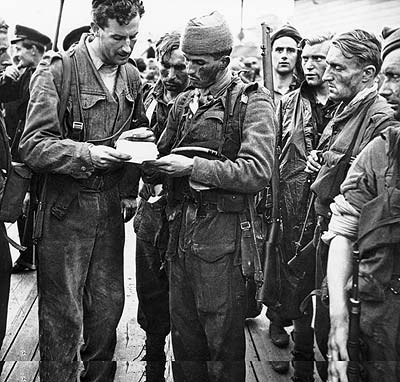
LAC photo PA 183766
Lord Lovat (left) and Captain Boucher-Myers from 4 Commando in discussion after the Dieppe Raid.
The next raid was launched several weeks later, on the night of 14/15 July. It was unimpressive in terms of both execution and results garnered. “The raid was a very amateurish affair,” confided Lieutenant-Colonel Durnford-Slater, the designated raiding commander, “from which we were very fortunate to return.” He explained that “everything was faulty from the higher direction in London down to the landing craft and our own training.”40 The intent was to conduct a small raid on the Channel island of Guernsey to seize some prisoners and to gather as much information as possible, as well as to inflict the maximum number of casualties upon the Germans. However, the execution failed to meet the aim. Neither of the two groups participating achieved any real success.
“The raid was,” conceded Durnford-Slater, “a ridiculous, almost a comic failure.” He explained: “We captured no prisoners. We had done no serious damage. We had caused no casualties to the enemy... we had cut through three telegraph cables.” He added: “A youth in his teens could have done the same.”41 He was right. The poor results provided further ammunition for the critics. Those results also justified the censure of those who supported the commandos and the raids. Churchill angrily directed that there be no more “silly fiascos like those perpetrated at Boulogne and Guernsey.” He asserted: “The idea of working all these coasts up against us by pinprick raids is one to be strictly avoided.”42
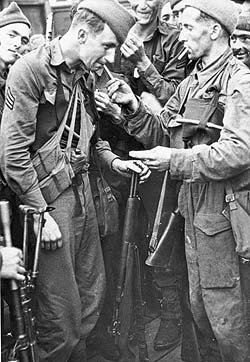
LAC photo PA 183790
Commando Sergeant A. Austin lights a cigarette for American Ranger Sergeant Alex Szima following a raid on the French coast.
Nonetheless, both the commandos and the raiding policy were allowed to evolve. But Churchill wanted the commando idea and the raiding concept to be conducted properly. Overall, the commandos came under the control of the Combined Operations Command (COC), which was responsible for raiding operations to harass the enemy and to cause him to disperse his forces. In essence, COC was the mounting authority for all raids from Northern Norway to the western limit of German-occupied France.43 Two days after the most recent fiasco, on 17 July 1940, Churchill appointed Admiral of the Fleet Sir Roger Keyes, the hero of Gallipoli and Zeebrugge, as Director of Combined Operations Command. “The truth of the matter,” confided Keyes to a friend, “is these irregular troops are very unpopular in certain quarters in the War Office. But, as you know, the Prime Minister is determined that five thousand shall be specially trained and available for raiding operations under my direction.”44 The change in command was also meant to mark the transition in policy from small to larger-scale raids, even though, for lack of enough ships and trained men, these raids could not be undertaken immediately.45
Despite the best efforts of the 68-year-old Keyes, he could not gain the cooperation of others, namely, the Chiefs of Staff of the different services. They consistently resisted his ideas and efforts. “I have not yet acquired patience, and am tired of having to waste time and energy,” wrote Keyes pleadingly to Churchill, “trying to overcome the supine objections of our own people in order to make real war on the enemy.”46
The growing strain and enmity between Keyes and others, not surprisingly, resulted in his eventual removal. Keyes was replaced by Lord Louis Mountbatten in October 1941, who was given the title “Chief Advisor of Combined Operations” and the rank of acting commodore. Approximately, six months later, in April 1942, Churchill, desperate for offensive action, appointed Mountbatten the Chief of Combined Operations, and promoted him to the rank of vice-admiral, and also bestowed upon him the equivalent honorary rank of lieutenant-general in the army and air marshal in the air force. Churchill also made him a de facto member of the Chiefs of Staff Committee. As such, Mountbatten was the only individual other than the King to have rank in all three services.47
Churchill now pressed the young, energetic and well-connected Mountbatten to make real progress. “My task, he [Churchill] told me,” revealed Mountbatten, “was to continue the Commando raids in order to keep up the offensive spirit, gain essential experience, and to harass the enemy.”48 He added; “Above all, I was to prepare in every possible way for the great counter-invasion of Europe.” The Prime Minister summed up his expectations succinctly. “I want you [Mountbatten],” he directed, “to turn the south coast of England from a bastion of defence into a springboard of attack!”49
The commandos themselves also saw change, and underwent several transitions. In December 1940, they were renamed Special Service Units. However, by February 1941 the Special Service Units were split up and commandos, as independent units, emerged once again. This was a result of the decision to deploy a number of commandos to the Middle East. Nonetheless, the eleven existing commando units were grouped in a Special Service (SS) Brigade. The SS Brigade’s primary mission remained that of carrying out raids. However, it was also given the secondary tasks of acting as an elite or shock assault brigade to seize and hold a bridgehead and to cover a landing in force, as well as to provide especially trained covering forces for any operation.50
Evolution and Improvement
In the end, despite the rocky start, with time came more experience and skill, and with that came success. Undeniably, commando raids commenced slowly. Only three were conducted in 1940, 10 in 1941, and 21 in 1942. But by 1943, they reached a high water mark of 31 raids.51 However, by this time, the momentum of the war had swung irretrievably into the Allied camp and large-scale conventional operations were now not only possible, but the predicted outcome was also more favourable. Not surprisingly, as a result, the commando organization became fixed, and they began increasingly to resemble a regular line battalion. Moreover, commando operations became more conventional in nature, specifically to assist with large attacks – normally being used on the flanks or as specialized amphibious assault troops to overcome difficulties that would stymie regular troops with less training and motivation. In addition, their preferential status with respect to the assignment of personnel also evaporated as manpower became scarce, particularly as commando requirements increased, due to a high number of casualties, normally resulting from their employment in conventional operations. Overall, ‘raiding for raiding’s sake’ was no longer necessary. As such, independent commando operations that relied on speed and surprise by lightly armed forces were increasingly marginalized, as military commanders now reverted to their preference for more powerful conventional forces that could crush the German opposition with mass and firepower.
Nonetheless, despite the slow start and relatively short history, commando raids were successful and they achieved their aim. They not only raised public morale, but they also forged a record for perseverance and toughness, as well as tactical, and at times, arguably, strategic success. Within the first two years of their existence, commandos achieved remarkable results.
For instance, the raid on the Italian Tragino aqueduct on 10 February 1941 by 38 commandos so unnerved the Italians that they diverted valuable manpower and resources in its aftermath for the protection of every vital point in the country.52 The succession of raids in Norway destroyed shipping, war industry and vital supplies, and captured prisoners. In addition, key intelligence was gleaned from maps, code systems, valuable documents and the seizure of spare wheels for the German cipher machine codenamed “Enigma.” More importantly, the raiding policy in Norway had another tangible payback. Aside from the destruction and intelligence coups, it resulted in a diversion of enemy manpower to counter further such attacks that totalled 372,000 troops by June 1944.53
But Norway was not the only area of continuing success. On 27/28 February 1942, another raid with strategic implications was conducted against a known German radar installation in Bruneval, France. It housed the state-of-the-art Würzburg radar system that vectored German fighter aircraft onto individual British bombers. The captured equipment led to the development of countering chaff decoys. Moreover, the raid buoyed public morale at a time when Britain had just lost the city of Singapore, as well as two battleships in the Far East.54
Yet another example of a successful raid with strategic implications was the attack on the French port of St. Nazaire on the night of 27/28 March 1942. It destroyed the only dry dock on the Atlantic coast large enough to service the German battleship Tirpitz, which the Allies feared could slip into the Atlantic as a surface raider and play havoc with the vital Allied convoys from North America. In a remarkably bold attack, an old destroyer, the HMS Campbeltown, laden with five tons of explosives, bluffed its way past the enemy defences and rammed the dry dock. Although the raid was extremely successful, very few of the raiding force survived to return to England.55
This sampling of raids conducted during the first two years of the commandos’ existence is not all-inclusive. However, it does provide a representation of their eventual success. Moreover, Hitler’s extreme reaction to the commando raids is also a tangible, albeit dark, indicator of their impact. He issued the “Commando Order” of 18 October 1942, which directed that “all men operating against German troops in so-called Commando raids in Europe or in Africa are to be annihilated to the last man.” This desperate directive provides further testimony to the effectiveness of the commandos and the raiding policy. So incensed was the German dictator by their constant attacks that he ordered them killed “whether they be soldiers in uniform... whether fighting or seeking to escape... even if these individuals on discovery make obvious their intention of giving themselves up as prisoners.” He insisted that “no pardon is on any account to be given.”56
Conclusions
And so, undeniably, in the end, the creation of commandos and the inherent raiding policy that they represented was born from a position of incredible weakness. Devoid of equipment, adequate weaponry and a modern doctrine for warfighting, Britain needed a means to bolster morale, to maintain an offensive spirit, to develop battle experience and to attrit German military resources. Highly trained and motivated commandos, executing an aggressive raiding policy, were seen as the solution. With time and experience, the merit of this policy was borne out. And, in the process, the ground was prepared, albeit reluctantly by many senior military commanders, for the birth and the proliferation of modern special operations forces.
![]()
Bernd Horn, an infantry officer, is currently Director of the Canadian Forces’ Leadership Institute at the Canadian Defence Academy in Kingston.
Notes
- Hilary St. George Saunders, The Green Beret. The Story of the Commandos (London: Michael Joseph, 1956), p. 118.
- Cecil Aspinall-Oglander, Roger Keyes. Being the Biography of Admiral of the Fleet Lord Keyes of Zeebrugge and Dover (London: Hogarth Press, 1951), p. 380.
- Ibid.
- Quoted in John Terraine, The Life and Times of Lord Mountbatten (London: Arrow Books, 1980), p. 83.
- Winston S. Churchill, The Second World War. Their Finest Hour (Boston: Houghton Mifflin Company, 1949), pp. 246-247. See also Colonel J.W. Hackett, “The Employment of Special Forces,” RUSI, Vol. 97, No. 585, February 1952, p. 28.
- Colonel D.W. Clarke, “The Start of the Commandos,” 30 October 1942, p.1. PRO, DEFE 2/4, War Diary Combined Operations Command (COC).
- Ibid. And Hugh McManners, Commando. Winning the Green Beret (London: Network Books, 1994), p.7; and “Commandos,” Canadian Army Training Memorandum (CATM), No. 20, November 1942, p.20.
- Patrick Cosgrove, Churchill at War – Alone 1939-1940 (London: William Collins Sons & Co. Ltd., 1974), p. 95.
- See Eliot A. Cohen, Commandos and Politicians (Cambridge: Center for International Affairs, Harvard University, 1978), pp.37-40; Maxwell Schoenfeld, The War Ministry of Winston Churchill (Ames: The Iowa State University Press, 1972), p.124.
- Quoted in William Stevenson, A Man Called Intrepid (Guilford, Connecticut: The Lyons Press, 2000), p. 131.
- Combined Operations. The Official Story of the Commandos (New York: The Macmillan Company, 1943), p. 16.
- Clarke, “The Start of the Commandos,” p. 2.
- “Early History - Interview with Colonel Dudley Clark,” 30 October 1942. PRO, DEFE 2/4, War Diary COC; Brigadier Peter Young, Storm from the Sea (London: Wrens Park, reprint 2002), p.8; Combined Operations, p.4; John Parker, Commandos. The Inside Story of Britain’s Most Elite Fighting Force (London: Headline Book Publishing, 2000), pp.19-21; Brigadier John Durnford-Slater, Commando (Annapolis: Naval Institute Press, reprint 1991), p. 14.
- Clarke, “The Start of the Commandos,” p. 2.
- Combined Operations, p. 5.
- See Peter Wilkinson and Joan Bright Astley, Gubbins and the SOE (London: Leo Cooper, 1997), pp.50-68; and Combined Operations, p. 5.
- Aspinall-Oglander, p.381; Durnford-Slater, Commando, p. 14.
- “Hand-out to Press Party Visiting The Commando Depot Achnacarry, 9-12 January 1943,” p. 2. PRO, DEFE 2/5, War Diary COC [henceforth “Hand-out”].
- “Hand-out,” p.2; and Young, Commando, p.12.
- Durnford-Slater, Commando, pp.15, 20.
- “Hand-out,” p. 2.
- Brigadier T.B.L. Churchill, “The Value of Commandos,” RUSI, Vol. 65, No. 577, February 1950, p. 85.
- Charles Messenger, The Commandos 1940-1946 (London: William Kimber, 1985), p. 411.
- Combined Operations, p. 7; and Durnford-Slater, Commando, p.15.
- Saunders, The Green Beret, p. 29.
- “Role of the Special Service Brigade and Desirability of Reorganization,” p.2. PRO, DEFE 2/1051, Special Service Brigade; “Organization and Training of British Commandos,” Intelligence Training Bulletin No. 3, Headquarters First Special Service Force (FSSF), 11 November 1942, p. 5. DHH, file 145.3009 (D5), Organization and Instructions for the 1st Canadian Special Service Battalion.
- “Role for the Special Service Brigade...,” pp. 3, 10; “Hand-out,” p. 2; and “Commandos,” CATM, p. 29.
- “Notes on Commando Training,” 1 November 1942, para 5. PRO, DEFE 2/4, War Diary, COC.
- “Notes on Commando Training,” paras 1-18; “Organization and Training of British Commandos...,” FSSF, 11 November 1942, p. 4; Combined Operations, pp. 6-8; “Role for the Special Service Brigade and Desirability of Reorganization,” pp. 10-11; and Saunders, The Green Beret, pp. 36-38, 41-42.
- “Notes on Commando Training,” 1 November 1942, paras 1-18; Combined Operations, pp. 6-8; and Saunders, The Green Beret, pp.36-38, 41-42.
- Brigadier Peter Young, Commando (New York: Ballantine Books, 1969), preface.
- Julian Thompson, War Behind Enemy Lines (Washington D.C.: Brassey’s, 2001), p. 2.
- Churchill, Their Finest Hour, p. 467.
- “The Role of the Special Service Brigade...,” p. 13.
- Churchill, Their Finest Hour, pp. 165-166; and see also Ronald Lewin, Churchill as Warlord (London: B.T. Batsford Ltd., 1973), p. 51.
- Churchill, Their Finest Hour, p. 466.
- Churchill, Their Finest Hour, p.467; and Robert W. Black, Rangers in World War II (New York: Ivy Books, 1992), p. 8.
- “Interview with Colonel Dudley Clarke.”
- See “Interview with Colonel Dudley Clarke”; Combined Operations, pp. 18-21.
- Saunders, The Green Beret, p. 30
- Durnford-Slater, Commando, p. 2.
- Quoted in Ibid., pp. 32-33; and Aspinall-Oglander, p. 383.
- “Draft Directive to Director Combined Operations,” 12 October 1940. PRO, DEFE 2/1, War Diary Independent Companies. See also Rear-Admiral J. Hughes-Hallett, “The Mounting of Raids,” RUSI, Vol. 65, No. 580, November 1950, pp. 581-582.
- Letter, Roger Keyes to Anthony Eden, 7 October 1940. PRO, DEFE 2/1, War Diary Independent Companies.
- Combined Operations, p. 26; and Young, Commando, p. 15.
- Quoted in Aspinall-Oglander, p.407. See also Will Fowler, The Commandos at Dieppe: Rehearsal for D-Day (London: Harper Collins, 2002), p. 25.
- “Commandos,” CATM, p. 31; and Thompson, p. 11.
- John Terraine, The Right of the Line. The Royal Air Force in the European War 1939-1945 (London: Hodder and Stoughton, 1986), p. 559.
- Terraine, The Life and Times of Lord Mountbatten, p. 85.
- “Organization and Training of British Commandos...,” FSSF, 11 November 1942, p. 2.
- See “Amphibious Warfare Headquarters Small Scale Raids in Europe.” PRO, DEFE 2/694. There were only four raids conducted in 1944.
- Eric Morris, Churchill’s Private Armies (London: Hutchinson, 1986), p. 163; and Adrian Weale, Secret Warfare (London: Coronet Books, 1997), pp. 63-64.
- Philip Warner, The Special Forces of World War II (London: Granada, 1985), p. 78; and Parker, Commandos, p. 42.
- Combined Operations, pp.65-70; Thompson, pp. 293-295; A Wing Commander (anon), “The Bruneval Raid,” Royal Air Force Journal, Vol. 2, No. 5, May 1944, pp. 159-160; and “The Bruneval Raid,” War, No. 32, 28 November 1942, pp. 6-10.
- Combined Operations, pp. 71-100; Denis and Shelagh Whitaker, Dieppe. Tragedy to Triumph (Toronto: McGraw-Hill Ryerson, 1992), p.48; and Hughes-Hallett, “The Mounting of Raids,” pp. 583-584.
- Reproduced in Parker, Commandos, pp. 2-3.



